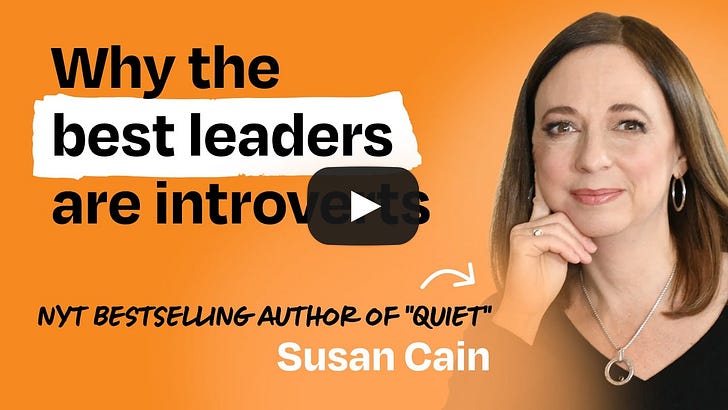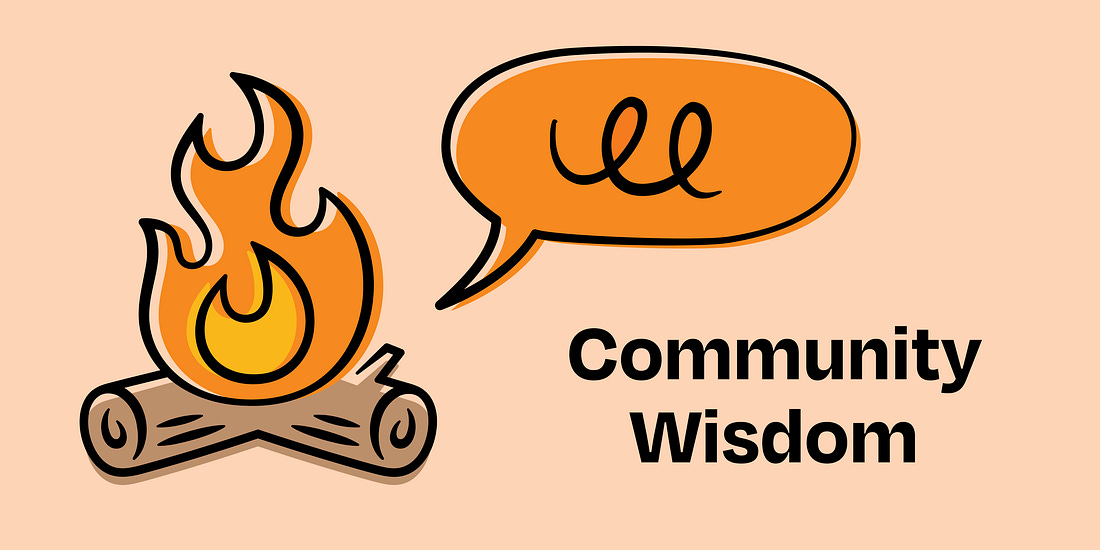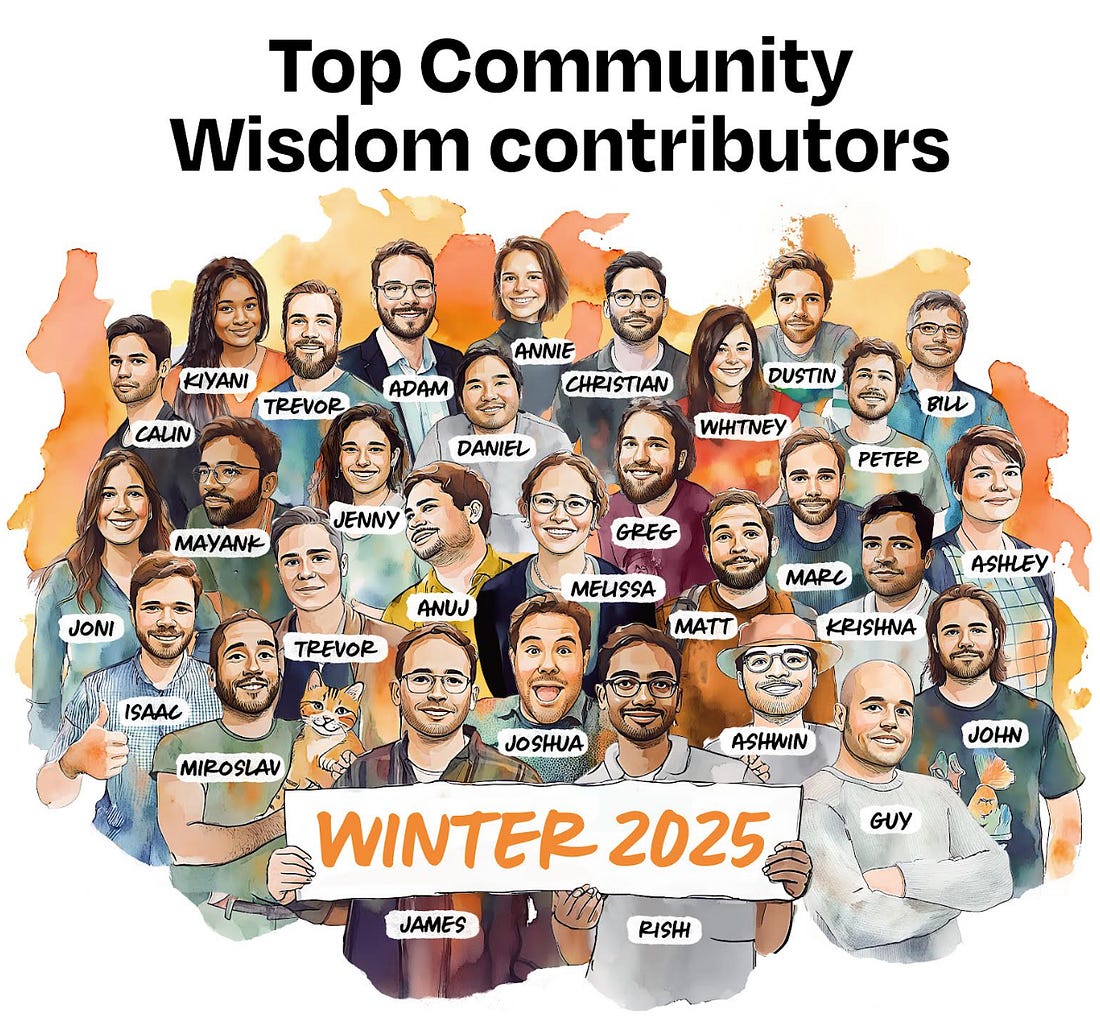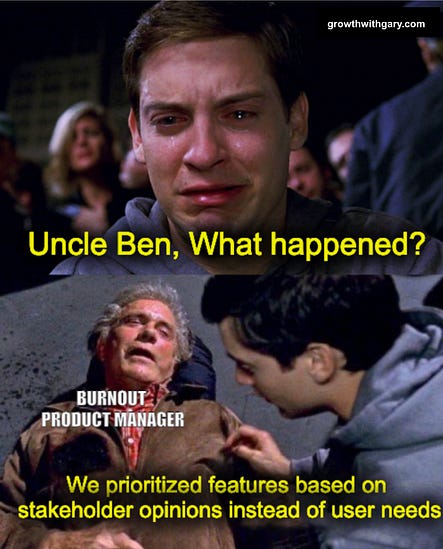🧠 Community Wisdom: 225th issue + balancing child care and career transitions, pregnancy disclosure in new roles,…
👋 Hello and welcome to this week’s edition of ✨ Community Wisdom ✨ a subscriber-only email, delivered every Saturday, highlighting the most helpful conversations in our members-only Slack community. A big thank-you to this month’s community sponsor, Chameleon. Tired of disruptive onboarding tools? Chameleon lets you guide users with inline, non-intrusive messaging that feels like part of your product, not a band-aid for bad UX. Deliver beautifully designed nudges tailored to each user’s journey, enhancing adoption and engagement without interrupting their flow. Chameleon is giving away a one-year Reforge membership at chameleon.io/lennys—check it out! 🌟 Meet your Community Wisdom Top Contributors—Winter Class 2025 🌟I’m thrilled to announce that we’re celebrating the 225th issue (!!!) of Community Wisdom this week, and, per tradition, meet your Winter Class 2025 of top contributors 🙌 This group brings together the most active and helpful community members over the past six months. By asking great questions, participating in conversations, or simply recommending great articles, they’ve all helped us learn and get better at what we do. Thank you for sharing your knowledge with us: James Conway, Joshua Herzig Marx, Anuj Adhiya, Rishi, Miroslav Pavelek, Guy Peled, John Conneely, Ashwin, Trevor Heselton, Matt Gonzales, Greg Docter, Krishna AG, Marc Dupuis, Bill Seitz, Isaac Krasny, Ashley Rolfmore, Joni Hoadley, Mayank, Whitney Gibbs, Călin, Daniel Heo Lu, Adam White, Trevor Acy, Melissa Appel, Peter Berg, Christian Limon, Dustin Coates, and Jenny Wanger 👏👏👏 📚 Join our community's new book clubCommunity leader Akil Bhagat is launching a monthly book club in our Slack community. If you’d like to join, please comment on this post. Members are currently voting on the first book selection. ✨ Upcoming community meetups ✨Upcoming community-organized meetups this month—click the city name to RSVP:
Can’t find your city and want to host one? Just DM @Riya in our Slack. It takes 10 minutes (i.e. pick a date and location), and you get to meet awesome people from our community. Learn more here. 🎙️ New podcast episode this weekThe hidden power of introverts: How to thrive without changing who you are | Susan Cain (author of “Quiet”): Apple, Spotify, and YouTube  💥 Top threads this week1. Measuring retention metrics effectively
Nick Markman: If it’s a metric you plan to run experiments against, optimize, etc., I tend to prefer “on” just given a faster feedback loop, but if doing “on” I would consider first making sure “d1” is the right time measurement. Do you have data to suggest that your day 1 retained are more valuable than, say, your week 1 retained? That specific time measurement will be different depending on your business, customers, etc. Justin Goff: This is a whole rabbit hole and a half to go down. My short answer would be to measure retention “on” D1 for a daily-use consumer app. If your goal is daily use, then anyone who doesn’t come back on D1 is at risk of not forming a daily habit. Also, as @Nick Markman said, measuring retention “on” D1 gets you faster results. Not sure if you want the longer answer, or if you want to dive into scenarios where “on or after” might make more sense. Let me know! Rajesh Raghavan: Thanks, Nick and Justin. We are measuring “on” exactly for those reasons—to run faster A/B tests on onboarding changes etc. We also have a lot of reinstalls for our app (about 30% of new installs every day are reinstalls). So measuring “on or after” is significantly improving our retention metrics. So we are unclear as to which one we need to consider for increasing our DAU. But I would love to know when “on or after” will make more sense Justin Goff: I’ve typically used “on or after” when one or more of the following is true:
So you should optimize for both D1 “on” and “on and after” to improve DAU. Rajesh Raghavan: This is super-useful, thanks for sharing! 2. Retroactive defining the product requirements
Isaac Krasny: In that situation, rather than trying to work backwards and post-rationalize features that are already being built, I’d focus my product efforts on understanding how you’ll measure the success of those features. What metrics will you want to look at, and who are the stakeholders who will be most impacted by those features? Why did the team decide before you joined that those were the features to build? While it wasn’t your decision to build the things, you will be on the hook for helping to roll them out, maintain them, and determine their relative priority as you move forward. You should try to gather the information you’ll need to do those things. Nick Markman: ^ this plus if any of the “mid-flight” things haven’t been fully committed yet, you could ask the team if there are any uncertainties or assumptions that came up before you joined that they could use your help pressure-testing in terms of the business case and user value before moving forward. Joshua Herzig-Marx: And make sure it’s really clear to you (and everyone else) the problem that your product brief is meant to solve. Liz Love: Do you still have access to the person/people who made the decisions to build these features? Could you get some information from them? Also, if there are features which aren’t actually commitments, and you could theoretically change the plans, don’t rule out the idea of doing so, especially if there isn’t a clear reason for building them (after some initial research). Christoph Steinlehner: What the people above said. Plus, write down who is the customer/user of this feature, what the expected product outcome is, and how it ties to strategy and business impact. Start by collecting what people think. This should help you understand what to measure and the unspoken expectations. And maybe it even nudges the development of the solution more in a specific direction.I find Impact Mapping as a model for these conversations helpful: Shifting from Feature Requests to Outcomes: Reverse Impact Mapping Frank Lee: Isaac gave a great answer—totally agree on not just post-rationalizing. One thing might be helpful to add in the exercise of getting the team’s thoughts down: Are there any edge cases or risks in the current plan that the team didn’t think about that are worth surfacing before the team gets too deep on one specific path? Is there a light pre-mortem you can do in parallel? 3. Balancing child care and career transitions
James Conway: Oh wow, that sucks. Having gone through a job search after the birth of my first daughter (wow, it was six years ago this week!), I’m going to assume it’s your first child so everything is new for you.
John Conneely: Thanks for sharing, @James Conway! I’ve actually since turned the content from this blog and another around mock interviews into a custom GPT on ChatGPT. More details on how to use it can be found here, but if you just wanna go straight to ChatGPT you can find the custom GPT here. Hopefully that helps! James Conway: Great idea, @John Conneely! Miroslav Pavelek: “My only hope right now is that the job market will look different (for better or for worse) by the time I am job hunting 15 months from now.” When you are on parental leave, from time to time, ask your (ex-)colleagues and friends what’s new, and try to keep in touch with them so your network doesn’t forget about you. Otherwise, I would do nothing. You cannot prepare for what will be in a year and a half right now, and you should focus on your current problem—legal consults—and the child. John Conneely: Thanks again for the inspiration, @James Conway. 4. Pregnancy disclosure in new roles
Emerie Lukas: That is stressful. What is the policy for ppl with fewer than 12 months of tenure? If I were you, I probably would share with an HR rep once I got to 10-12 weeks, but not necessarily with the goal of asking for an exception unless they have no leave policy for folks under 12 months… which seems a little surprising. At the end of the day, if you wouldn’t leave the company over this, I would probably just do my best to be communicative and transparent about the surprise of the moment. Good luck! Christian Limon: At the 1K-employee stage, if they aren’t reasonable and accommodating, leaking the info is fair game I’ve heard, but this not legal advice. Greg Docter: “The company has a policy that supports up to 16 weeks of parental leave to those who have worked at the company for 12 months”—I am hopeful that your company is not full of a**holes and will extend this policy to you and understand why you didn’t tell them until month #3/4/5/whatever feels right to you. From an outsider’s perspective, I think it’s going to be okay and congrats on joining the company of your dream! Anji: First off, congrats! If it were me, I would wait till probation assuming it’s 3 months, so that would put you about 17ish weeks into the pregnancy, where your ultrasounds might also be done. Once you establish trust is when I’d bring it up, because unfortunately pregnancy discrimination is very common, and you want to be on slightly firmer ground wrt performance, i.e. pass probation. If the probation is 6 months, then none of what I said applies and you’re going to have to make a judgment call. I hope they are accommodating, but if they are not, this is not an employer that would be great to work for post-maternity-leave either, so either way you’ll know before you give birth and need that extra support. I feel like no matter how and when you inform and how they react, you’re entering a new phase of life, and in hindsight this stress would resolve itself one way or another. 5. Discounts for existing subscribers
Mayank: I don’t think there is a way to not alienate existing subscribers without giving them a discount. Even if you remove those 100 users from the FB campaign so that they do not see your promotion, word of mouth will reach them and they will come to your support team. And when the renewal time comes, they will cancel their existing subscription and wait for a new promotion. So in my opinion, here is the balancing act: tell your existing users that they will get a discount on their next renewal. You can decide the discount percentage. Christos Apartoglou: One idea would be to change the packaging, e.g. you can offer a discount for a 6-month or an annual commitment (assuming your customers do not already sign up this way). Another option is to focus on benefits that are more relevant to new subscribers vs. existing ones that are not price-specific but would be of equal value, e.g. a migration service. Something else? (Hard to propose something without knowing the nature of your app.) Sapan Narang: A few ways to incentivize the existing members that I have seen working—you can choose to run some of them in parallel. I do not know the ins and outs of your product, so some of these may not be applicable.
One other thing to keep in mind—if there is an opportunity to learn directly from the user on product feedback, don’t leave it on the table. E.g. “one more ask”—please respond to survey and get an offer over and above the existing ones. I have seen multiple times in my career that users have a much higher rate of response to surveys when they are a part of such campaigns. The campaigns I have run include outcomes on feature feedback, brand/product positioning, and upcoming feature prioritization. Some food for thought. Ana: You can do a tiered price where the old users have more functionalities and the new, that you give the discount to, will have less. 🤓 Top finds
😂 Meme of the weekHave a fulfilling and productive week 🙏 If anyone in your life would benefit from this newsletter or community, consider giving them a gift subscription 💞 There are group discounts, gift options, and referral bonuses available. Sincerely, Kiyani 👋 Invite your friends and earn rewardsIf you enjoy Lenny's Newsletter, share it with your friends and earn rewards when they subscribe. |
Similar newsletters
There are other similar shared emails that you might be interested in:
- 🧠 Community Wisdom: Essential reading for early-stage founders, balancing unlimited SaaS plans with profitability…
- 🧠 Community Wisdom: Finding your voice on established teams, focus tips for ADHD brains, how to best use Granola,…
- 🧠 Community Wisdom: Designing great performance review templates, balancing oversight and autonomy with junior te…


